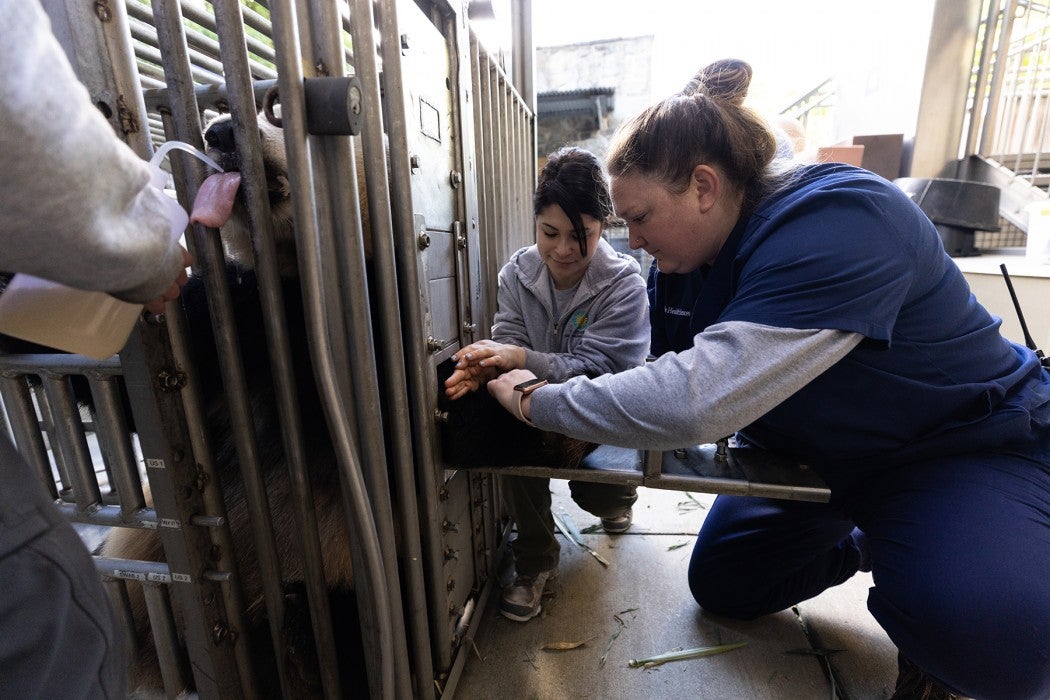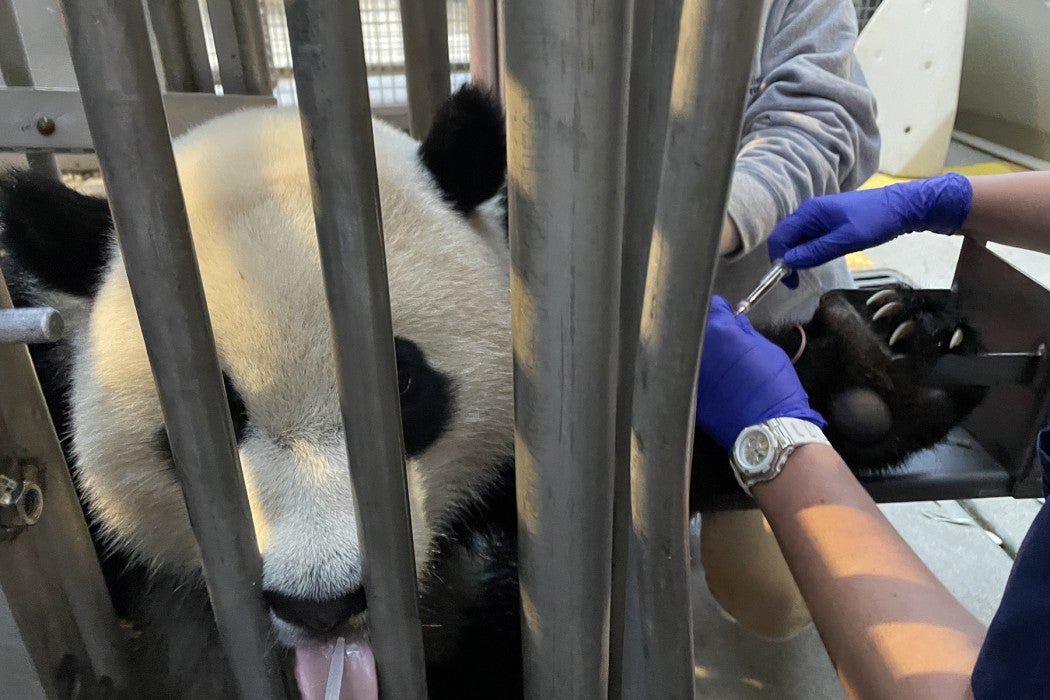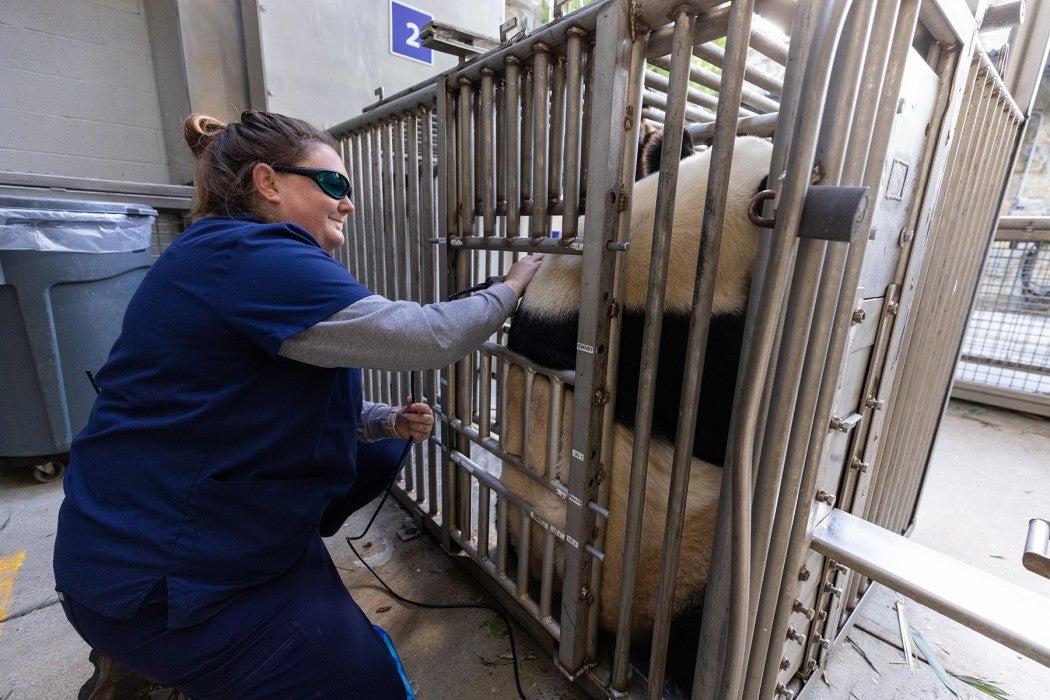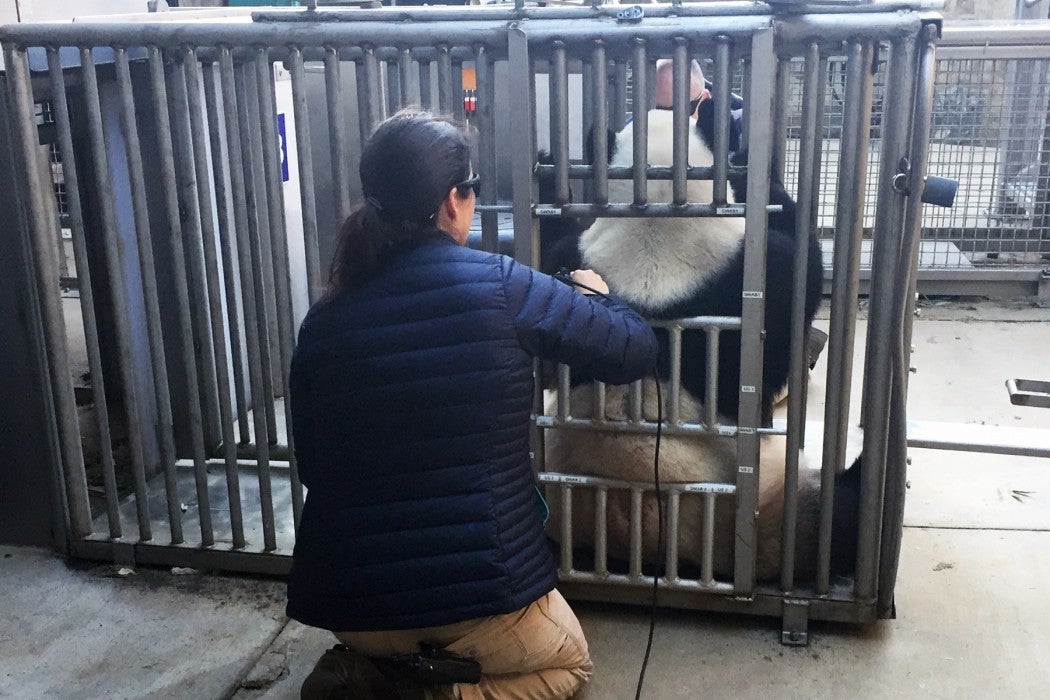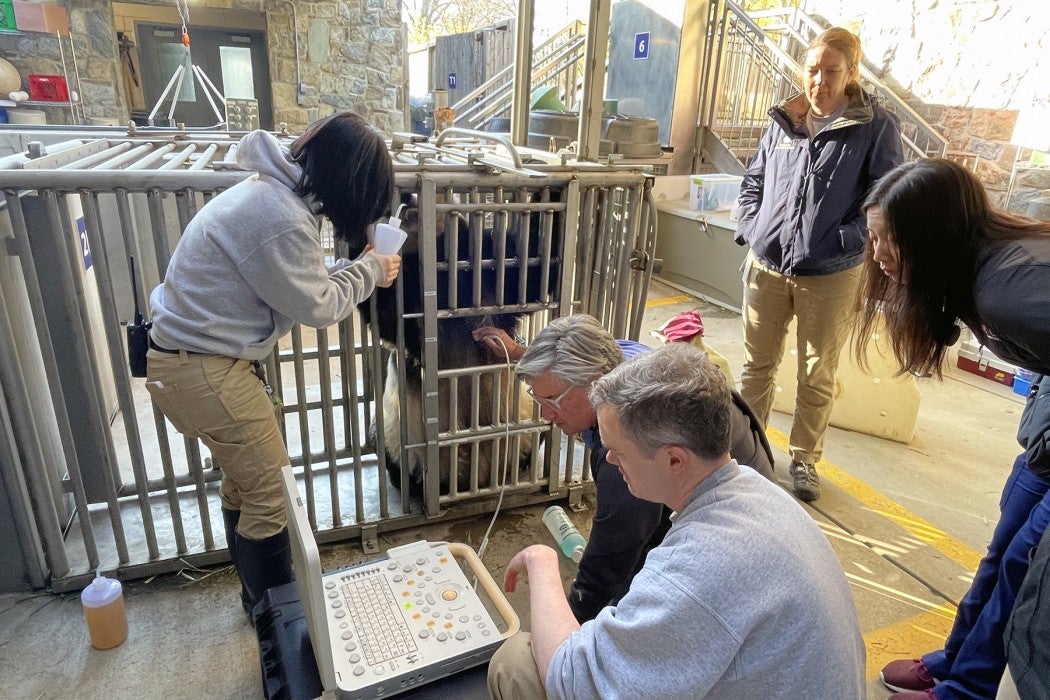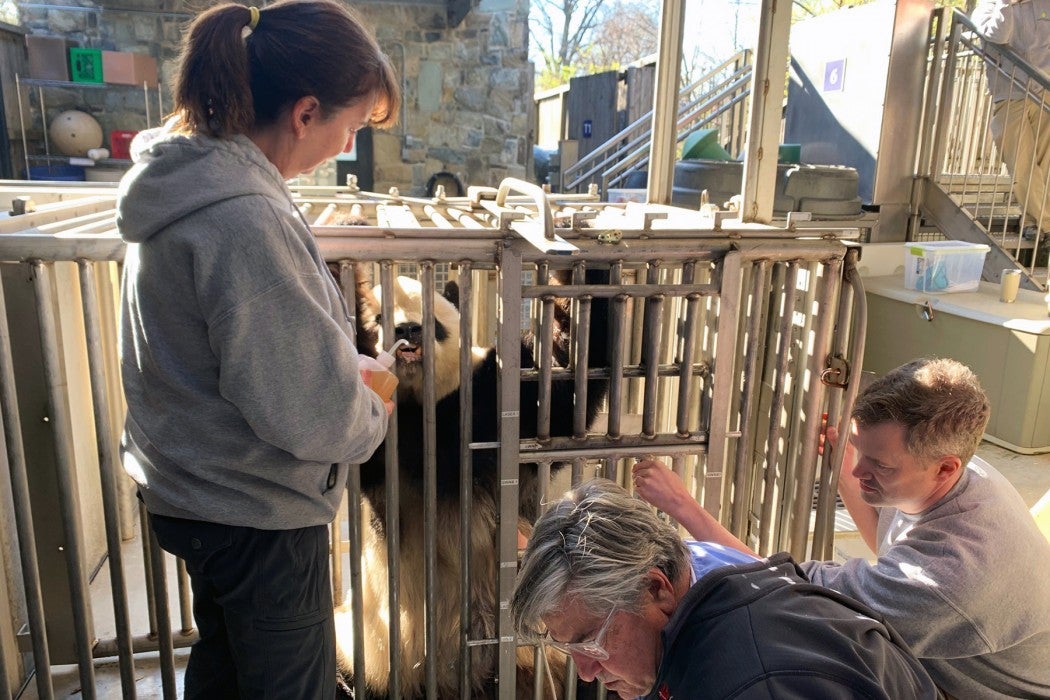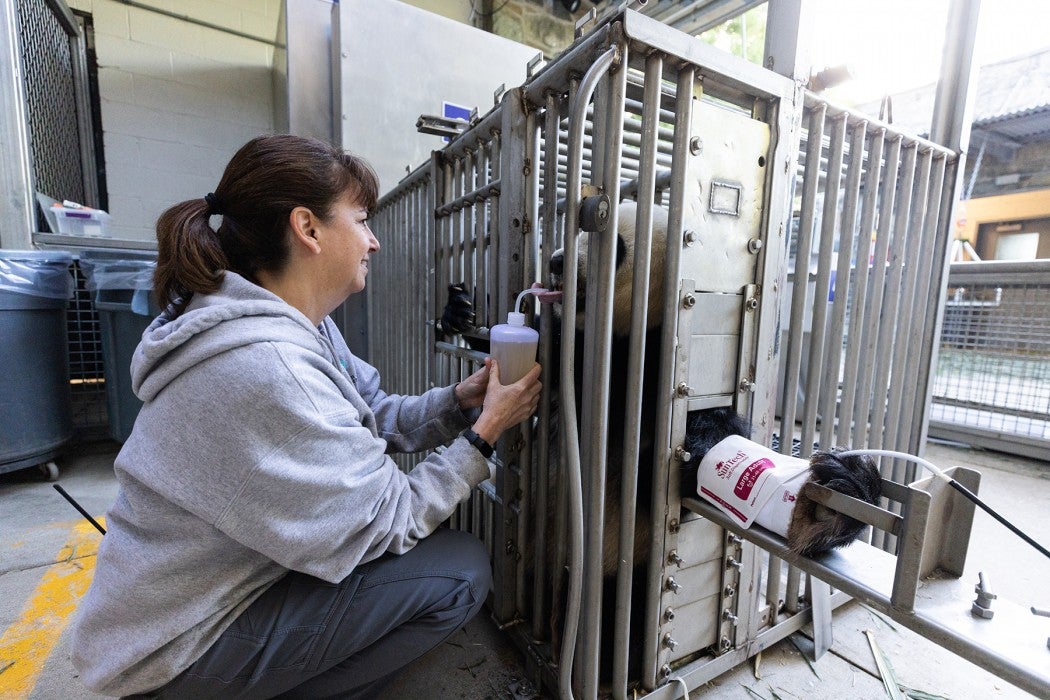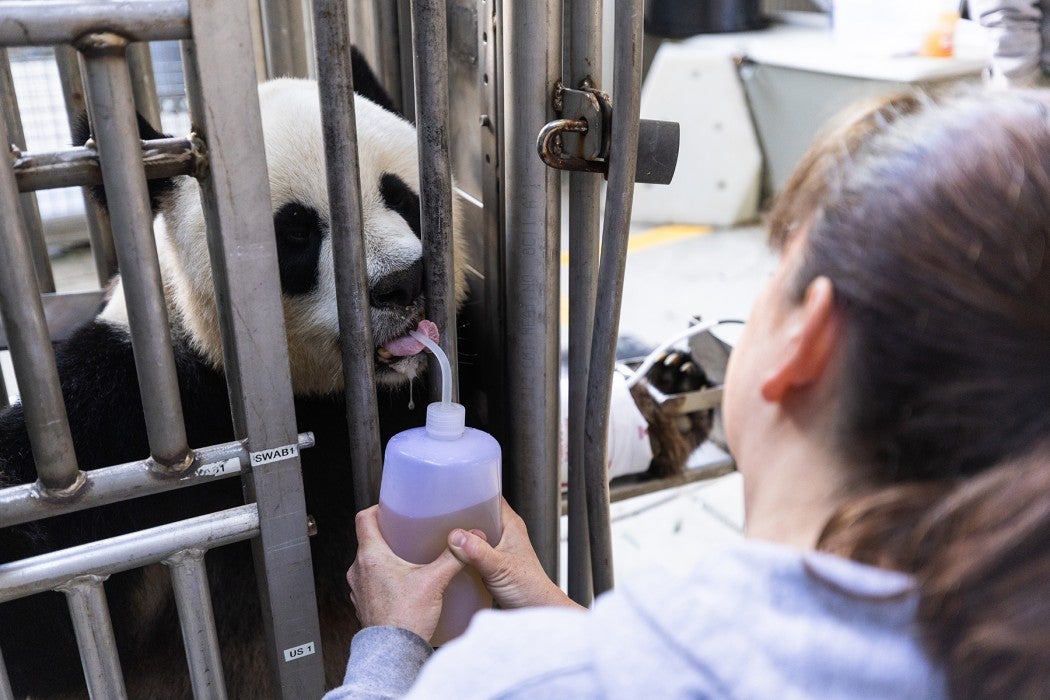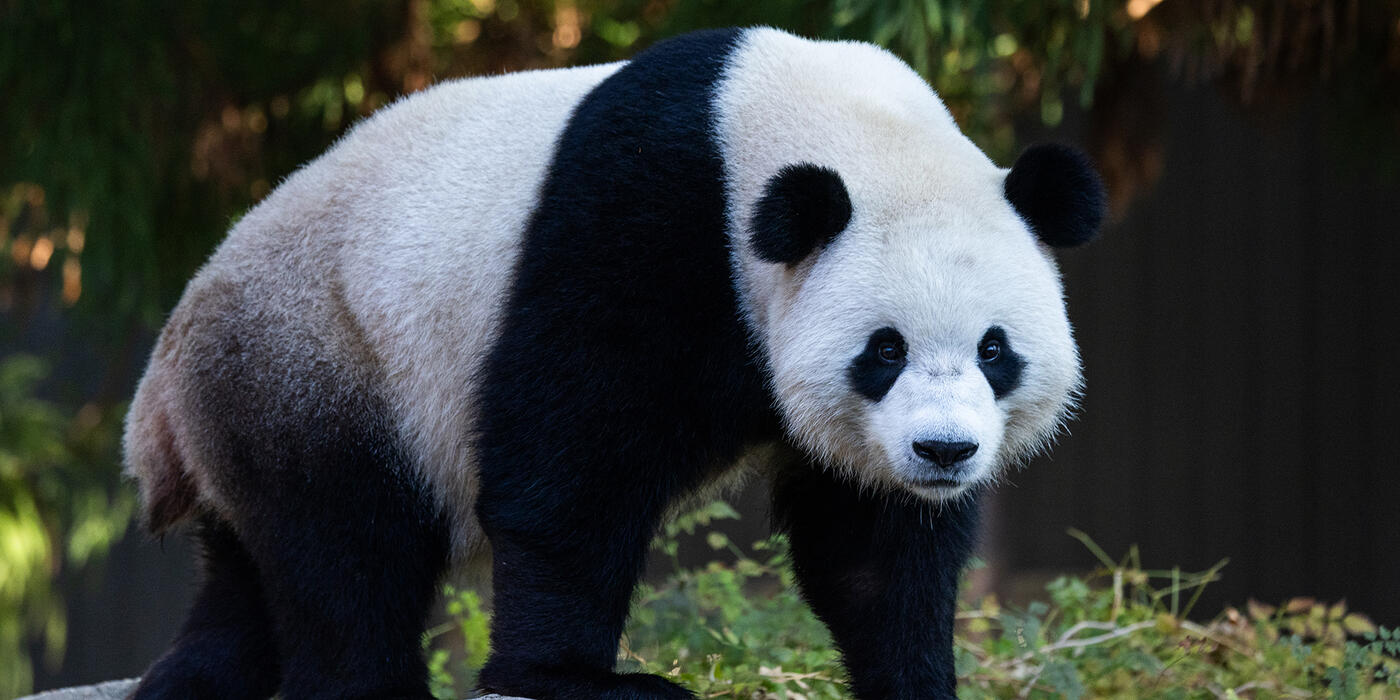The Science Behind Giant Panda Veterinary Care
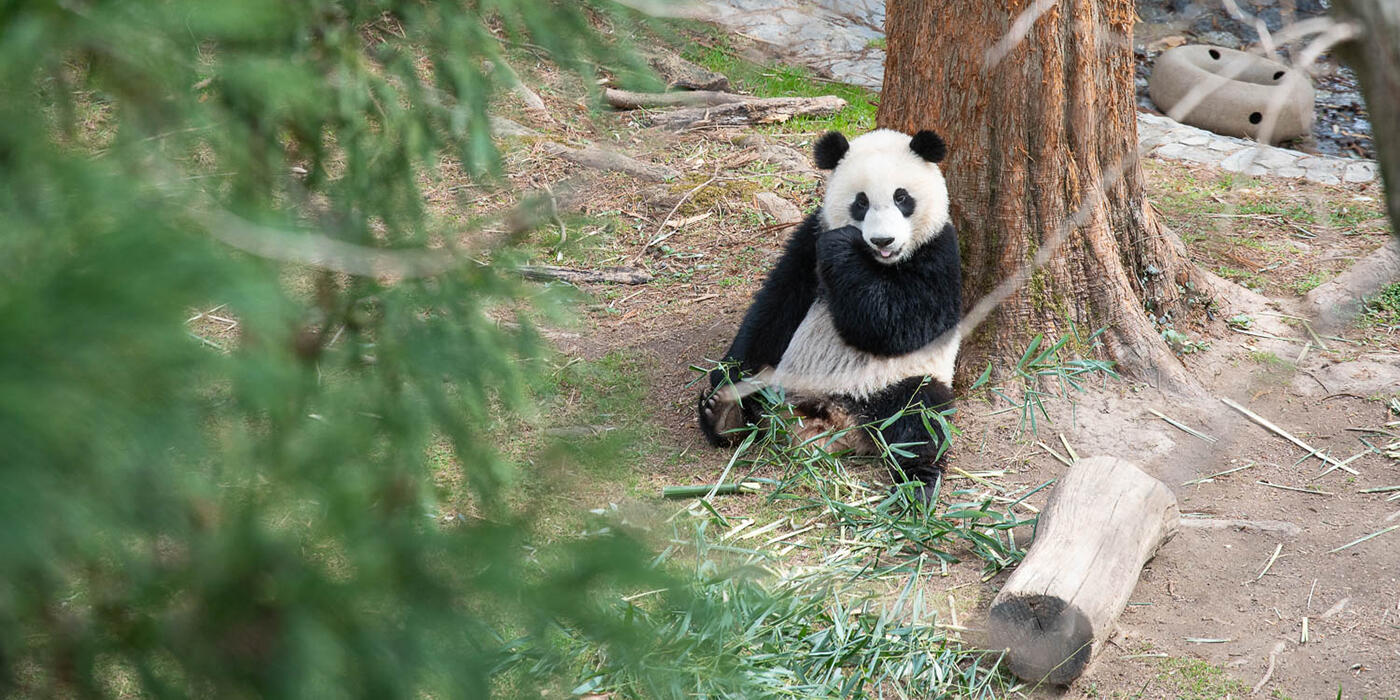
How do you train a panda to voluntarily participate in blood draws and other medical exams? By building the bears’ trust and rewarding their participation with treats! Using operant conditioning, our animal care team can conduct check-ups without the need for anesthesia. Learn how our experts monitor Tian Tian, Mei Xiang and Xiao Qi Ji’s health in this update from our animal care team.

Training has allowed for amazing advancements in the medical care of animals at the Smithsonian’s National Zoo and Conservation Biology Institute, including our giant panda family: 25-year-old adult male, Tian Tian; 24-year-old adult female, Mei Xiang; and their 2-year-old son, Xiao Qi Ji. Teaching the bears behaviors that enable them to voluntarily participate in their own healthcare takes coordination among our staff and, of course, the pandas!
Keepers interact with Tian Tian, Mei Xiang and Xiao Qi Ji one-on-one throughout the day and teach them behaviors that can assist us with their daily care. We train them using positive reinforcement, a type of operant conditioning where we pair desired behaviors with rewards in the form of attention or treats (their favorite foods).
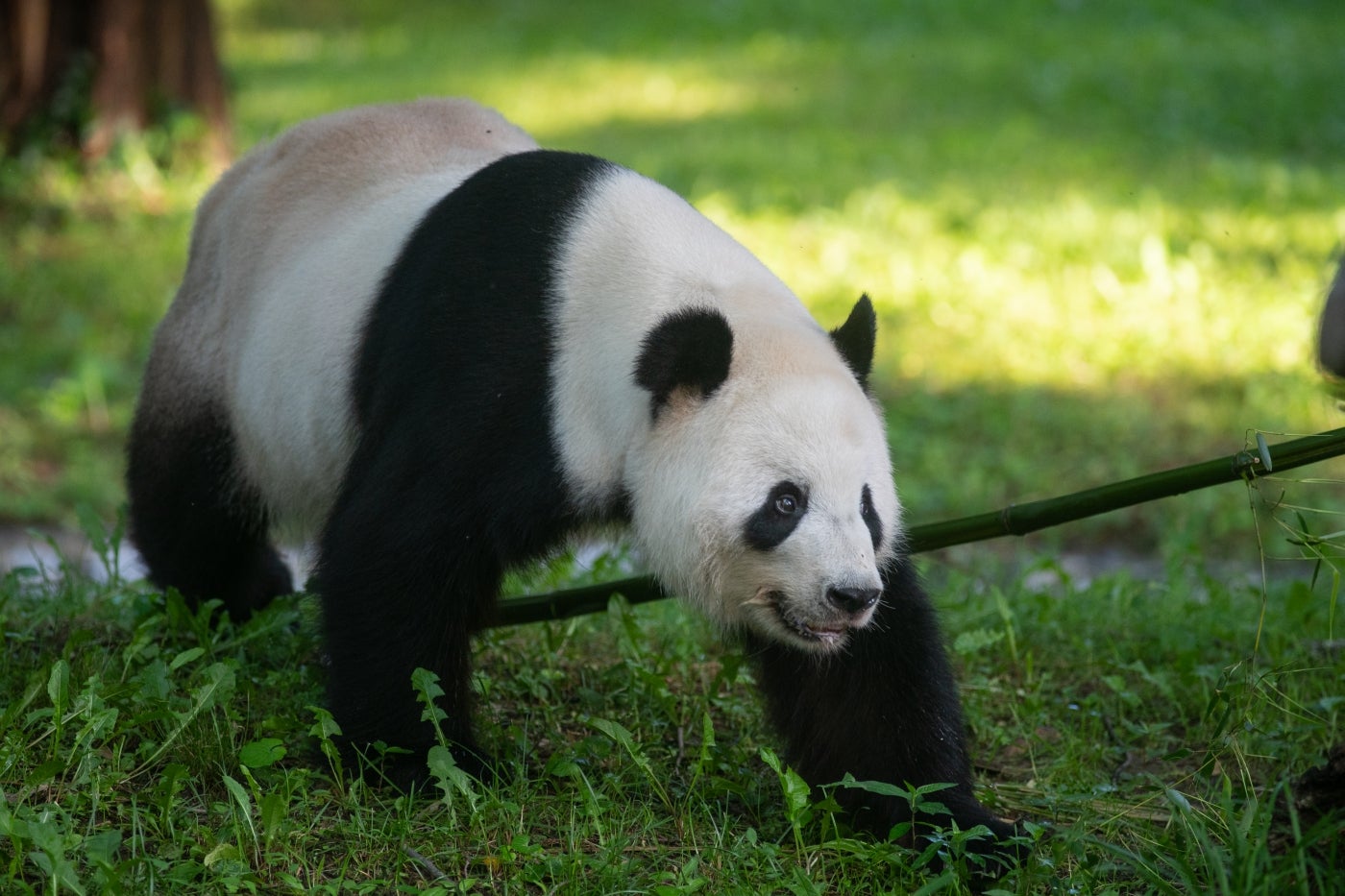
Training sessions are often a way for animals to work for something they want but may not need. The treat portion of the pandas’ diet is a bonus. We still give them bamboo, apples, pears, sweet potatoes, and high-fiber biscuits every day, even if they do not want to participate in a training session.
When we ask the pandas to do something, they can choose to voluntarily participate, knowing they will be rewarded. If they don’t want to participate, they don’t have to. These interactions help establish—and maintain—the important bond between an animal and a keeper.
Each bear has a unique personality and learns differently. When it comes to training, we treat each panda as an individual, and go at their pace. All know how to “shift” (move around their habitats), stand still on a scale and present parts of their body for evaluation on keepers’ cue.

The pandas also learn behaviors that make diagnostic exams run smoothly. Thanks to operant conditioning, the Zoo’s medical team can collect a blood sample, measure a panda’s blood pressure, administer vaccines and photobiomodulation therapy, and obtain radiographs, echocardiograms and abdominal ultrasounds, among other behaviors. More often than not, the pandas willingly participate because they know they will receive a favorite treat afterward.
Importantly, operant conditioning allows our team to conduct exams on the pandas while they are awake, lessening the need to anesthetize them. Awake exams allow us to get more accurate values and improve our interpretation of the giant pandas’ health status.
Training 101
To communicate with Tian Tian, Mei Xiang and Xiao Qi Ji, we use a combination of verbal cues, training tools, hand signals and body gestures. The pandas interpret those cues to determine which behavior we are asking them to do.
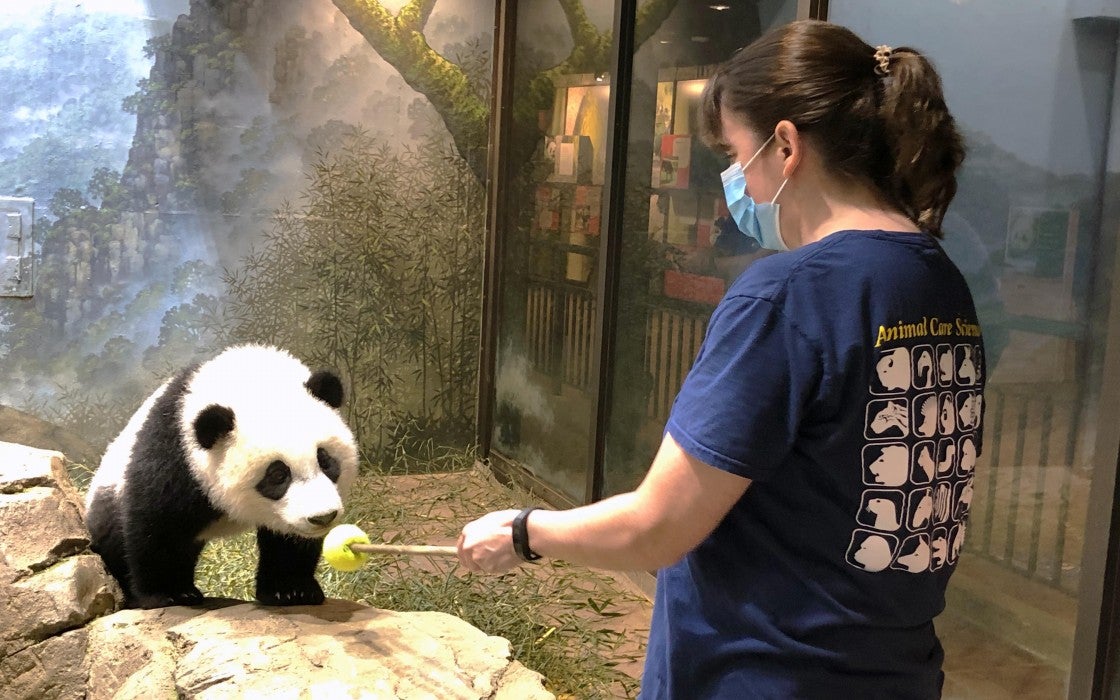
In May 2021, our giant panda team trained Xiao Qi Ji how to "target," or touch his nose to a ball on the end of a dowel. Every time he did so, the team immediately reinforced that behavior by offering Xiao Qi Ji a favorite treat.
One of the first behaviors our giant pandas learn is to “target,” or move toward a ball on the end of a dowel. When we hold out the target, the pandas instinctively sniff to investigate it. Every time a panda touches their nose to the ball, keepers say “good job” to let them know they have done the correct behavior and immediately reinforce that behavior with a favorite treat. Xiao Qi Ji began target training when he was around 9 months old and received pieces of sweet potato, apple and pear as his reward.
Once Xiao Qi Ji mastered target training, we were able to teach him more complex behaviors. When he was around 10 months old, he learned how to “stand up” on cue. To give the signal for this behavior, a keeper holds their hand in front of Xiao Qi Ji’s face, points their index finger up to the sky, then slowly raises it. Xiao Qi Ji follows their finger and stands up on his hind legs.
This behavior gives us an up-close view of a panda’s torso, front legs and hind legs that we would not see if they were farther away. We can check their mobility and note any issues that might need medical attention. The first time Xiao Qi Ji did this behavior successfully, he received a nutrient-rich biscuit and a very enthusiastic “good boy!” Like his parents, Xiao Qi Ji is a quick learner. He mastered this behavior on his second try!
Blood Draw Training
Blood samples are an important diagnostic tool for monitoring the pandas’ overall health. To participate, a panda must voluntarily enter a chute, place their arm through a small window and hold on to a bar underhanded for a few moments.
Xiao Qi Ji figured out that he needed to place his arm through the window in the very first training session. It took about four sessions for him to learn that we wanted him to grab the bar underhanded, and it took another three sessions to perfect his holding of the bar reliably in the correct position. To simulate the prick of the needle, we used our fingers to gently poke his arm.
It was a very proud moment for our team when Xiao Qi Ji had his first successful blood draw, and we are so happy that he mastered this important behavior so quickly! For his excellent participation, Xiao Qi Ji received honey-flavored water and lots of praise from his keepers.
Photobiomodulation Therapy
At 25 and 24 years old, Tian Tian and Mei Xiang are considered geriatric for their species. Like many aging animals, they have osteoarthritis—a degenerative disease affecting joint cartilage and the underlying bone with associated pain and stiffness. To keep them comfortable, our veterinary team conducts photobiomodulation therapy treatments on both Tian Tian and Mei Xiang once a week. During the procedure, the pandas calmly sit in the training chute as a veterinary technician massages their left shoulders with a probe. As with all medical behaviors, keepers reward them with honey-flavored water to reinforce their participation.
Monitoring Heart Health
Cardiac disease can be present in giant pandas as they age. To track Tian Tian and Mei Xiang’s heart patterns and rates, keepers have trained them to voluntarily participate in echocardiograms. During these exams, our medical team looks at all aspects of their hearts’ functionality, including how they are pumping and if there have been any anatomical changes to the valves or muscle.
They present their chest while sitting upright or lying down in a prone position. That way, our medical team can capture the best view of a panda’s heart from multiple angles. Our giant panda team practices touching Tian Tian and Mei Xiang’s chests with the cardiac probe several times. This ensures the pandas are comfortable with the process before the real 20-minute exam begins.
Measuring Blood Pressure
Aging pandas may develop systemic hypertension, or elevated blood pressure. The pandas participate in weekly awake blood pressure measurements. Similar to blood pressure tests for humans, these exams involve placing a blood pressure cuff around the arm of the panda. Then, the machine squeezes the panda’s arm to get the reading. Keepers typically take between two-to-three readings to ensure they are consistent.
Body Condition Scoring
How do we know if a panda’s diet is supporting its health and welfare? With body condition scoring! Along with weight measurements and diet reports, we can use this tool to assess whether a panda is eating the right amount of food and is within a healthy weight range. Fat is necessary, but animals can run into problems with too little or too much. These exams help us check whether an animal has the right amount of fat.
During body condition scoring, a nutritionist touches the area along a panda’s shoulders, spine, ribs and hips. The panda needs a strong relationship with their keeper to be comfortable with a stranger touching them from behind. Luckily, the assessments only take a few minutes and for the animals, it is like a mini massage with a special reward of honey-flavored water at the end!
Typically, body condition score exams only happen every 3 to 6 months. If there are other factors that lead staff to be concerned about an animal’s condition—such as weight fluctuations or changes in their activity levels—then they may occur more frequently.
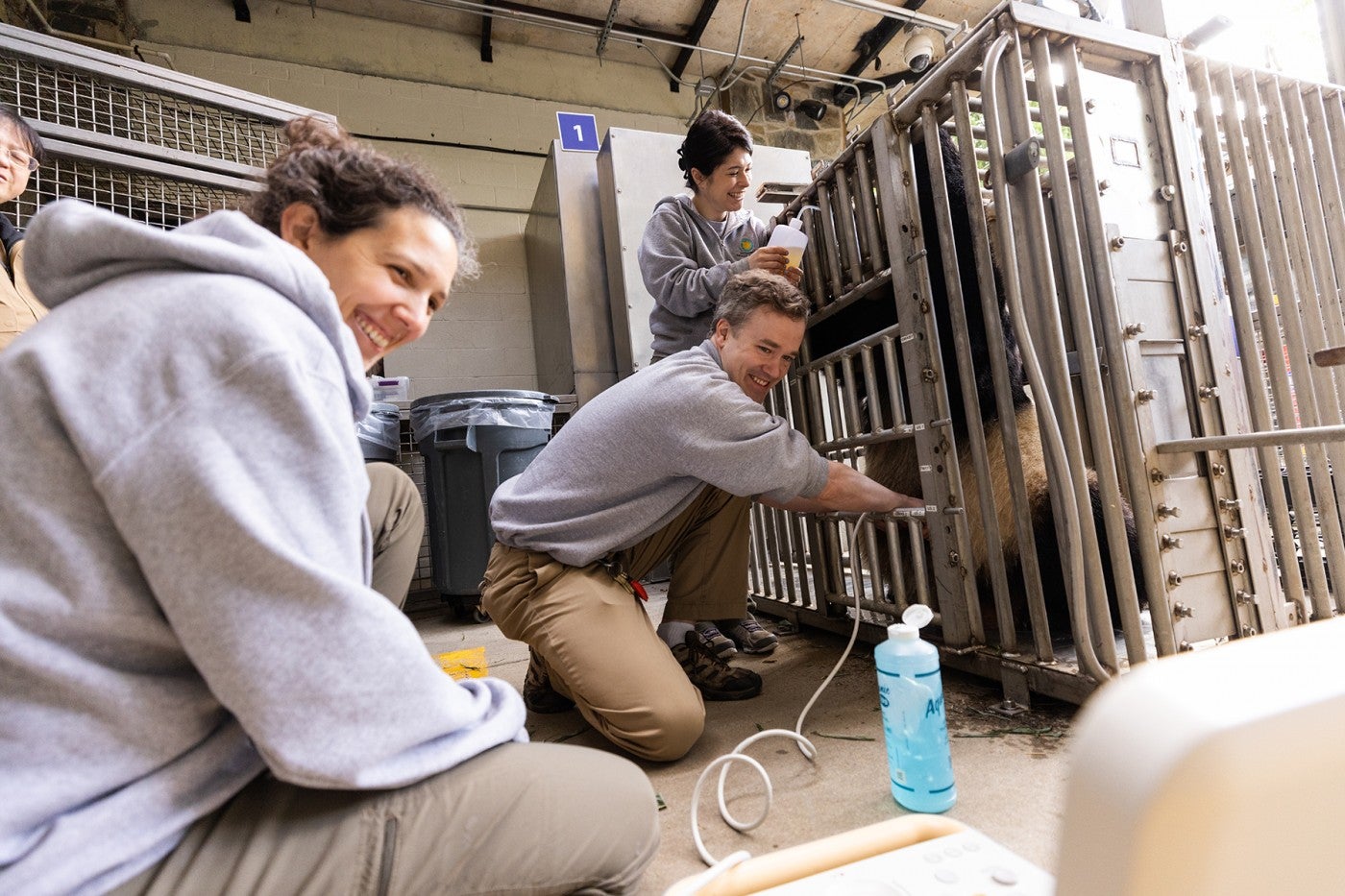
Ultrasounds
Just like humans, sometimes giant pandas have health concerns that keepers cannot assess by sight alone. Veterinarians use abdominal ultrasounds to check if a panda has any internal organ damage, masses or fluid accumulation. Ultrasounds also allowed the care team to monitor Mei Xiang’s past pregnancies.
Like echocardiograms, ultrasounds involve a veterinarian pressing a probe to the panda’s abdomen while they are either sitting up or lying down. Mei Xiang participates in ultrasounds readily, and Tian Tian also lies down on cue for the 15-to-30-minute exam.
Radiographs
Veterinarians take radiographs to monitor the pandas’ internal organs, joints and skeletal system. If the care team notices any changes that indicate arthritis, they are able to provide pain management to keep the pandas comfortable (including the photobiomodulation therapy treatment mentioned above). We use voluntary awake radiographs to monitor Tian Tian and Mei Xiang’s shoulders for any changes that might require additional treatment.
The biggest challenge for radiographs is needing the bears to rest in different positions and stay still for the duration of the radiograph, but since this training behavior is practiced in all of our medical and training procedures, all three pandas are very skilled at this. Plus, they enjoy honey-flavored water throughout the exam!

Conservation and Collaboration
We hope this behind-the-scenes look at our giant panda care program gives you a deeper appreciation for these incredibly intelligent and charismatic bears! Thanks to the bonds keepers have formed with our pandas, we are able to view them up close, monitor their overall health, and administer treatments as needed.
Tian Tian, Mei Xiang and Xiao Qi Ji will be going to China before the end of the year. Working with giant pandas over the past 51 years — in collaboration with our Chinese colleagues — has allowed Smithsonian’s National Zoo and Conservation Biology Institute staff to contribute to the wealth of knowledge about their behavior, reproduction, ecology and health.
The pandas’ voluntary participation in medical training sessions, in particular, have helped support advances in giant panda care and conservation, not just in Washington D.C. and China, but around the world. The knowledge gained can be used by future generations of animal care professionals, veterinarians and researchers to care for giant pandas in human care and in the wild.
An effective animal training program—especially for medical behaviors—takes time, patience and a lot of trust from the pandas. It is a worthwhile investment that will benefit them—and their species—for many years to come.
This story appears in the May 22 issue of the Giant Panda Bulletin. Read previous #PandaStory updates here. Want to see the pandas in person? Plan your visit! The Giant Panda Cam is generously sponsored by Boeing.
Related Species:

